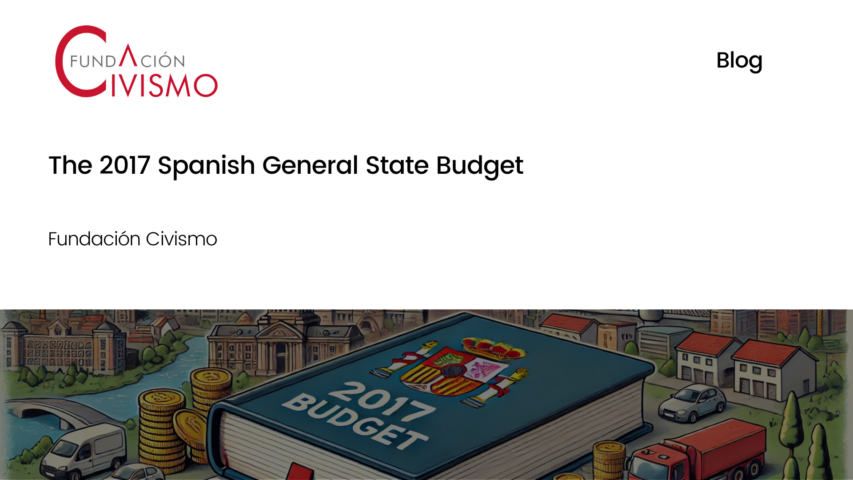The 2017 Spanish General State Budget

The 2017 Spanish General State Budget
Civismo // 12 April 2017
Last week, EPICENTER’s Spanish partner, Fundación Civismo, published a report about the Spanish General State Budget.
The 2017 General State Budget, presented on April 4th and essentially shared by almost all parties in Parliament, is based on inflated tax revenue forecast and consequently supports a level of public spending that is hard to justify, according to calculations by Think Thank CIVISMO. Even though the Spanish economy has improved considerably as a whole, public accounts remain affected by a medium–term sustainability crisis, which discourages waste.
Both the government and the opposition trust that the public debt objectives for 2017 will be satisfied by the growth of the economy alone ensuring that Spain may exit the Excessive Debt Procedure (EDP) in 2019. Trusting solely in revenues to enact an in-depth fiscal adjustment is a bad economic idea. Everything depends on the response of the tax base to the nominal growth of the economy and the frequent tax changes that take place. For instance, one of the most recent changes, the corporate tax hike totalling about six billion euros, allowed Spain to meet the deficit objective with a slim margin, causing innumerable headaches for the finance departments of companies.
The reactions of the tax base have varied greatly in recent years. Homogenous tax collection data since 2007 shows that for every percentage of variation in nominal GDP, taxes collected have only increased by 0.59 per cent. Given this inelasticity of the tax revenue (made worse during the crisis years and by the multiple tax hikes since 2010), it is unreasonable to think that an economy that grows by 3 per cent in real terms (5 per cent in nominal terms if we assume that inflation as measured by the GDP deflator is at an annual average of two per cent) could generate a near-8 per cent increase in homogenous tax revenue annually. Factoring in the government’s track record of overestimating revenues, this path to fulfilling promises on debt and deficit is called into serious question.
In terms of expenses, the cyclically-adjusted non-financial spending rises by 2.5% annually, indicating the expansive character of the 2017 budget. In particular, the use of territorial funds stands out. This harm to the Central Administration caused by the Autonomous and Local Administrations is escalated as Spain must contribute 825 million Euros net to the EU budget.
Another worrying aspect is the state of the accounts for Social Security. Beneath the supposed “fulfilment” of the deficit objectives lies the largest shortfall to date of more than 18 billion euros. With pensions spending growing faster than the economy (a projected +3.1% in 2017) and revenues covering just three-quarters of expenses, with serious deviations from the budget (15 billion in 2016), the problems facing the Social Security system are highly likely to get worse. This would worsen the structural deficit that our public redistribution system is currently facing.
Finally, another major problem in the General State Budget is the fantasy of controlling the public debt. Thanks to the latest methodological changes, Spain appears to have stabilized its levels of public debt measured against GDP at slightly below 100%. This is due to lower interest rates and a reduction in primary public debt of only five tenths of GDP. There is reasonable doubt as to whether this stabilization is structural or purely cyclical. Given nominal GDP growth of 5% and a nominal average servicing cost of 2.7%, it is impossible to start reducing the volume of public debt except if a primary surplus of around 2% of GDP were to be generated. This is especially true when the interest rates on the debt have already begun to rise, foreshadowing the increases that will gradually take place in the international markets.
In conclusion, the 2017 General State Budget is not what the Spanish economy needs. While there are positive aspects, such as investment in infrastructure, there is an overall lack of caution and absence of a ‘Plan B’ should some of the underlying assumptions fall through. The macroeconomic estimations of public consumption, investment and exports are generous, the translation of those estimations into tax revenue, increased expenditure and debt stabilization are equally generous.
EPICENTER publications and contributions from our member think tanks are designed to promote the discussion of economic issues and the role of markets in solving economic and social problems. As with all EPICENTER publications, the views expressed here are those of the author and not EPICENTER or its member think tanks (which have no corporate view).



